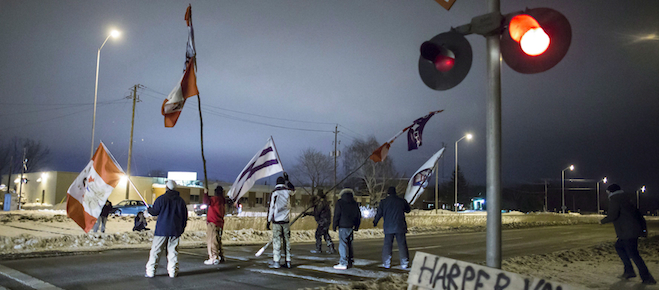Idle No More disrupts railway traffic, but CN fights back
The Aamjiwnaang First Nation uses a rail line blockade to protest near Sarnia, Ont.
First Nations protesters march down the railway tracks after abandoning their blockade of the CN tracks in Sarnia Ontario, Wednesday, January 2, 2013 after a court injunction ordered them to move. The protest, part of the Idle No More movement, has blocked the tracks for 13 days.THE CANADIAN PRESS/ Geoff Robins
Share

When the Aamjiwnaang First Nation in Sarnia, Ont., wanted to support hunger-striking Chief Theresa Spence they found a big and easy target in their backyard: the Canadian National Railway. Chief Chris Plain and about a dozen Idle No More supporters blocked the railway’s spur line leading in and out of one of Canada’s largest industrial complexes, Sarnia’s Chemical Valley. “It was an effort to target something that would get the federal government’s attention,” says Plain.
If Ottawa didn’t fully get the message, local industry did. CN and its customers took action, getting a court injunction on Dec. 21 to have the blockade removed. A week later, with protesters still there, CN was back in court saying jobs were at stake. The line is “a major piece of infrastructure serving major industry,” says CN spokesman Jim Feeny. “If you interrupt any part of that, you have an effect on our operation but also on the customers.” Imperial Oil scaled back gas production by 15 per cent due to the stoppage. The Canadian Propane Association warned that customers east of the city could soon face shortages. One of the biggest industries in the region, Nova Chemicals, also slowed production. With company lawyers calling the lack of rail service “disastrous,” it shut two chemical units and slowed production in its remaining unit.
Last week, Justice John Desotti ordered the blockade cleared: “You are an individual blocking the spur line affecting hundreds of people’s employment,” Desotti told a spokesman for the blockade. Losses are estimated to be in the millions. The Aamjiwnaang First Nation, however, doesn’t regret the action. If anything, they have proven why railways are likely to continue to end up in the crosshairs of demonstrators. Several Via Rail trains were blocked by native protesters in late December, stranding 2,000 passengers. There have also been rail disruptions in eastern Quebec and Sault Ste. Marie, Ont.
In Sarnia, while injunctions were issued, police were reluctant to make arrests for fear that matters would escalate. So while the tents stand on the rail lines and police look for a peaceful ending, industries can only sit by and wait.